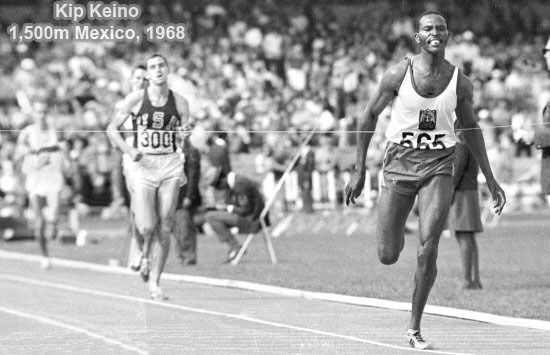What Makes Kenyan Runners Elite?
Kenyans and Ethiopians have a well deserved reputation as elite distance runners.
Kenyan runners toiled in obscurity until the 1968 olympics, when they surprised everyone by showing up with little fanfare, and then gently took an axe to the competition. Led by the charismatic Kipchogo Keino (pic 1), the east africans won 13 distance running medals and outran much better prepared western runners.
The success didn’t stop there. Over the next 40 years Kenyan runners won 40% of all international distance competitions, and acquired 10 of the top 20 cross-country word records.
A closer look at Kenyan runners revealed three surprising facts.
1). Almost without exception, they came from one tribe within the country.
2). Their diet upheld traditional canons of sports nutrition.
3). Their dietary intake uprooted commonly held perceptions about caloric and fluid intake.
Who Were the Kenyan Runners?
Almost every Kenyan runner comes an ethnic tribe called The Kalenjins, who live in the upper rift valley of Kenya. Kalenjins come from Nigoli ethnic descent and consist of a network of 8 smaller tribes that collectively total about 3 million people, about 10% of the Kenyan population and 0.0005% of the world population.
In Kalenjin villages running is a way of life, and male adolescents are often running 50-70 miles a week. Daily runs with your friends and village races are a way of life and a common way of assigning status within the village.
The Upper Rift valley is very mountainous and has low oxygen levels, and the terrain, cultural practices, and a few wins in the genetic lottery allowed the Kalenjins to ascertain the status of world’s greatest runners almost by accident. Curiously enough, the major running populations of the world are East Asian/Amerindians (Adriana Fernandez, Harumi Haroyama), northern Africa (Khalid Khannoucchi), and parts of southern Europe (Abel Anton of Spain), all of which share a large history of gene exchange with parts of eastern Africa. It’s an unvalidated and sensationalistic claim, but the area might be the cradle of human distance running.
What Do Kalenjin’s Eat?
To the disappointment of some, the Kalenjin diet doesn’t contain any exotic superfoods. No seeds, berries, or drinks that give ordinary runners extraordinary powers. Daily food intake consists mostly of corn, sweet potatoes, and other starchy crops mixed with vegetables. Beverages consisted mostly of water and milky teas, and goat is the meat most commonly consumed.
The staple Kalenjin meal is called Ugali, which is a paste made from cornmeal that’s typically served with stewed vegetables. The primary drink is Mursik, which is spiced fermented milk, somewhat similar to Kefir.
While the diet is fairly plain, it’s nutritional quality is very high. Kalenjin food is dense in micro-nutrients, and the carb/fat/protein ratio is about 80/10/10, which is close to ideal for intense distance running. Somewhat surprisingly, the Kalenjin diet is not calorically dense. Average caloric intake is about 3300 calories a day. Not much when you’re running 100 miles a week.
I might have averaged more during the holiday season. Yikes!
Kalenjin Lifestyle
The success of Kenyan runners has changed the modus operandi of Kalenjin runners somewhat. A national survey found that more Kalenjins are running, but economic motivations are occupying a larger portion of Kalenjin mindshare. Of the elite distance runners surveyed, only 4% said they do it for fun, and economic considerations were the biggest reasons most runners competed.
Kenya’s becoming increasingly urbanized, and the traditional tradeoffs seen in other modern countries are observed here as well. Life spans have gone up, and mortality rates and prevalence of infectious disease have gone down, but “diseases of convenience” are slowly beginning to take their toll.
A study published in the International Journal of Pediatric Obesity compared anthropometric data between urban canadian children and urban Kenyan children, and found a striking amount of convergence compared to their rural counterparts.


[…] by the amount of calories we eat. The average american eats about 3300 calories a day, which is actually more than the typical Kenyan olympic runner!The Okinawans have the highest proportion of centenarians in the world, but eat only about 1200 […]
LikeLike
[…] who win all sorts of Olympic long distance running events eat a food call Ugali, a paste made from cornmeal served with […]
LikeLike
[…] 6. Almost three quarters of all of Kenya’s athletics come from one tribe, the Kalenjins. – Source […]
LikeLike
What is your source for the national survey reporting 4% of Kalenjin runners do it for fun while economic considerations were the biggest reasons most runners competed? When did this survey take place? The Kenyan government conducted it? Thank you.
LikeLike
[…] 14. Almost three-quarters of all of Kenya’s athletics come from one tribe, the Kalenjins. – Source […]
LikeLike